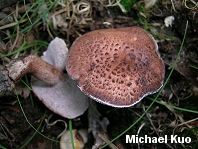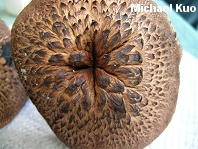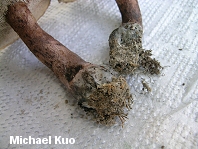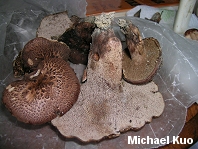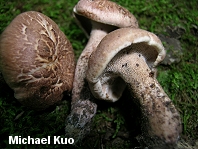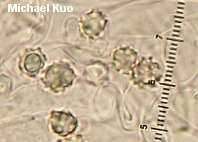| Major Groups > Toothed Mushrooms > Sarcodon > Sarcodon scabrosus |

|
Sarcodon scabrosus [ Basidiomycetes > Thelephorales > Bankeraceae > Sarcodon ... ] by Michael Kuo In theory, "Sarcodon scabrosus" is a widely distributed species in Europe and in North America, recognized by its brown to reddish brown or purplish brown colors; its appressed cap scales, which develop as the mushroom matures; its greenish to bluish or black stem base; its bitter taste; and, under the microscope, its lack of clamp connections. However, the reality is that Sarcodon scabrosus is a northern European species apparently mycorrhizal with pines (species of Pinus)--and it may or may not actually occur in North America, where we have a rather bewildering assortment of scabrosus-like mushrooms that differ slightly in morphology and that have evolved with widely different ecosystems and mycorrhizal hosts (see the comments below). Descriptions of Sarcodon scabrosus vary widely in North American literature, and competing taxon names include Sarcodon fennicus and Sarcodon underwoodii. The former is a Finnish species recognized in North America by some authors, including Smith, Smith & Weber (1981), who separate it from Sarcodon scabrosus on the basis of its not turning green in KOH; and Harrison & Grund (1987a), who say that it does turn green in KOH, but that its stem base is not greenish. Sarcodon underwoodii, according to Baird (1986b), is a hardwood-associated species with a yellow-brown cap, extremely bitter taste, and a stem base that does not develop green shades. Harrison and Grund agree on the cap color, hardwood habitat, and very bitter taste, but say Sarcodon underwoodii does have a green stem base. They maintain that Sarcodon scabrosus is associated only with conifers. Extensive molecular and ecological study of many well documented North American collections is obviously needed. Description: Ecology: As a species group, mycorrhizal with conifers and hardwoods; growing alone or or gregariously; summer; widely distributed in North America. Cap: 3-10 cm wide; convex to broadly convex with a central depression; dry; when young appressed-hairy to sub-scaly; with maturity developing well defined scales with darkened tips; reddish brown to purplish brown; the margin often inrolled. Undersurface: Running down the stem; covered with crowded spines or "teeth" that are 2-8 mm long; pale brown with whitish tips at first, becoming darker brown overall with age. Stem: 4-10 cm long; 1-2.5 cm thick; often tapered to the base, which frequently extends into the ground like a root; dry; fairly smooth, except where punctuated by aborted spines; pale or brownish; base with prominent white to pink mycelium over a greenish to bluish or black ground color. Flesh: Whitish to pinkish; gray to black or greenish in stem base; soft. Odor and Taste: Taste bitter (sometimes developing slowly); odor mealy, or not distinctive. Chemical Reactions: Flesh and cap surface at first green with KOH, then resolving to gray. Spore Print: Brown. Microscopic Features: Spores 5-7.5 µ; irregularly globose to subglobose; nodulose. Clamp connections absent. REFERENCES: (Fries, 1836) Karsten, 1881. (Saccardo, 1891; Maas Geesteranus & Nannfeldt, 1969; Smith, Smith & Weber, 1981; Arora, 1986; Baird, 1986a; Baird, 1986b; Harrison & Grund, 1987a; Barron, 1999; Roody, 203; McNeil, 2006.) Herb. Kuo 07180710, 07210701, 07220702, 07230805. This site contains no information about the edibility or toxicity of mushrooms. |
© MushroomExpert.Com |
|
Cite this page as: Kuo, M. (2009, February). Sarcodon scabrosus. Retrieved from the MushroomExpert.Com Web site: http://www.mushroomexpert.com/sarcodon_scabrosus.html |
